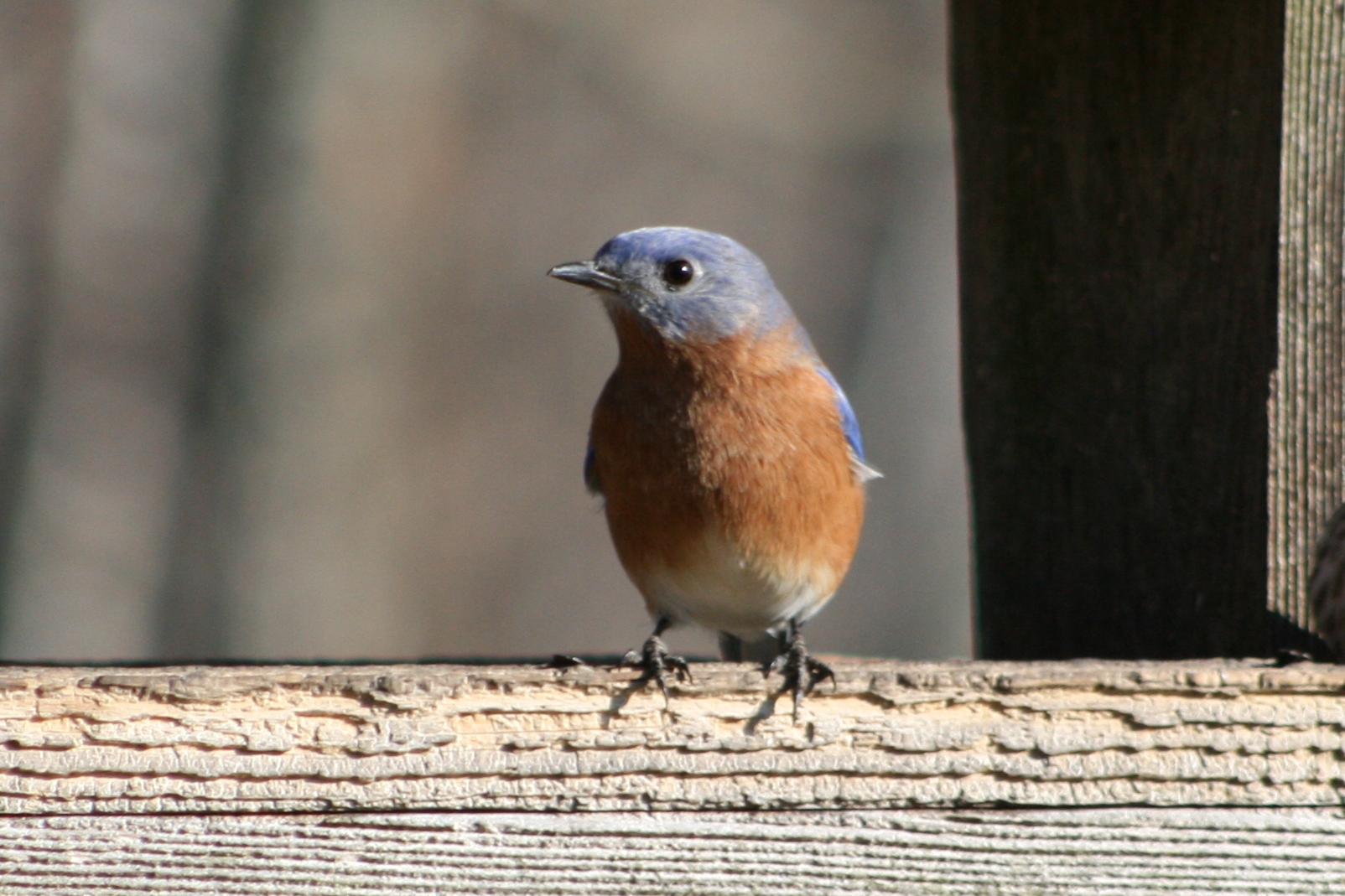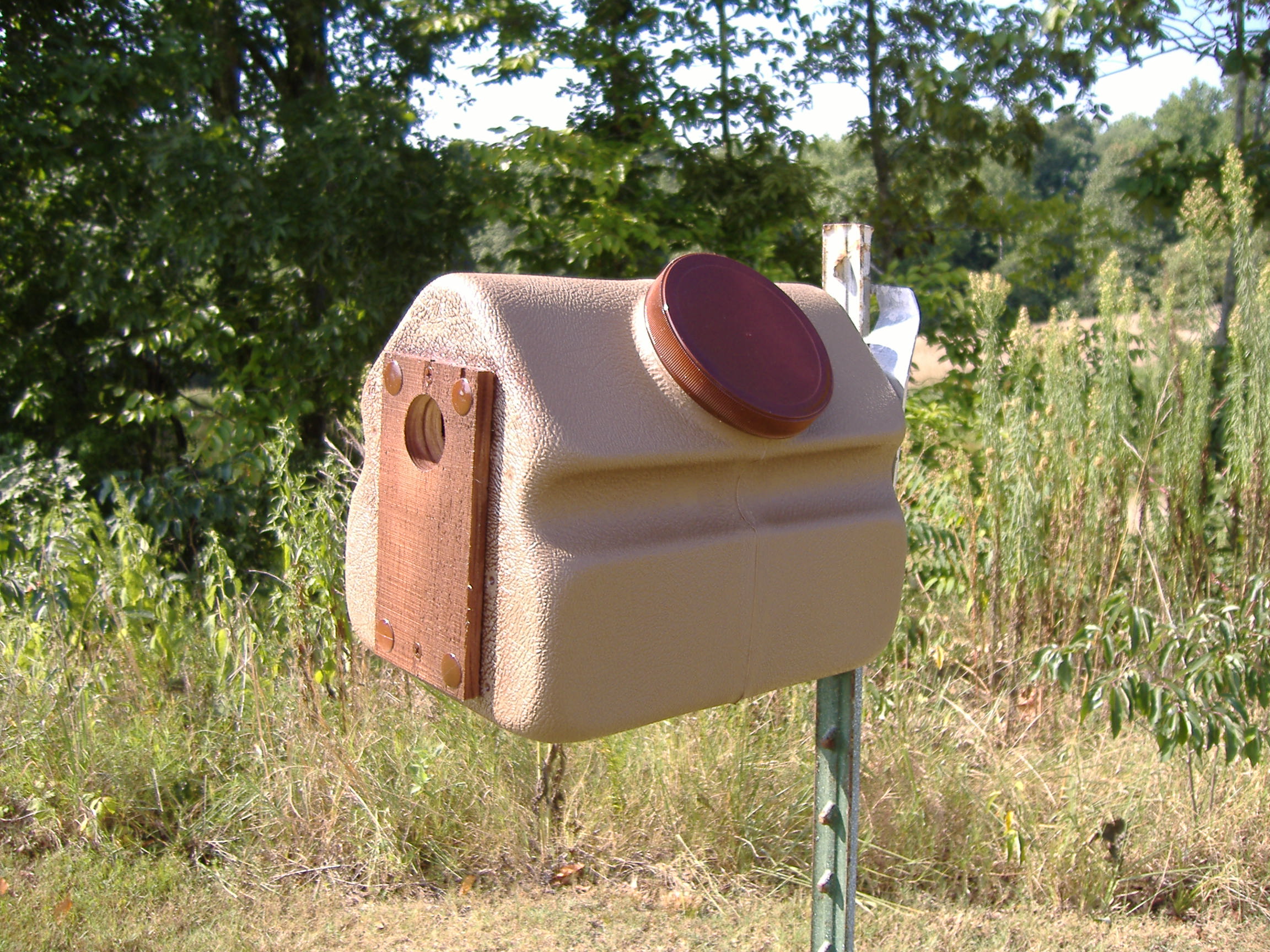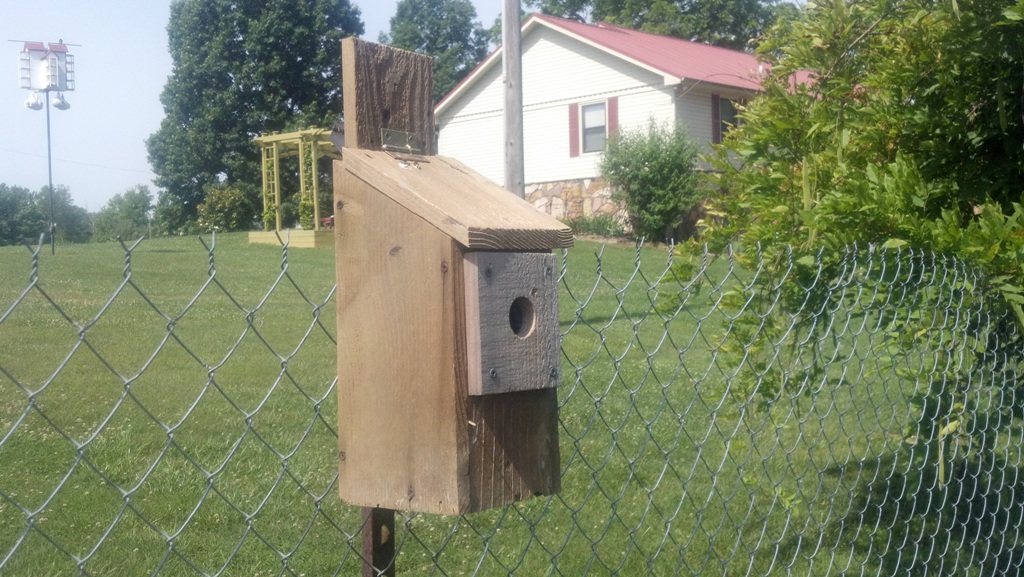
My Bluebird Trail

Although I have a deep love for Purple Martins, Bluebirds have been a part of my life from very early on. Coming from New York State where the Bluebird is the state bird, I've always tried to supply some type of housing for them.
When we first moved to Alabama in '85, they were one of the first birds I saw out and about and one of the first projects I had to do, once we got settled in our new home, was make a couple of bluebird boxes and get them out and about the property. As I looked around our new neighborhood, I didn't see many other boxes, so when I put mine up, it didn't take long and I had bluebirds move right in. We only had 2 1/2 acres at the time, and because of the spacing requirements, I had to figure out how to get at least 5 houses up while keeping the spacing requirements in mind. I wasn't surprised when, within a short time, 3 of the 5 boxes had BB's working on nests and another one had a pair of Chickadees move in.
After 17 years of living there, we decided to move further out in the country and we purchased the place where we now live. It has 25 acres and I now have plenty of room to do some of the other things I like to do and of course, put a bunch more BB boxes up. And to make things even better, we live at the very end of a 3 mile long 'dead end' road and after talking with a couple of the farmers that had plenty of road frontage about putting up some BB houses, I was able to supply an even larger number of boxes and now have a total of 36 boxes of various styles on 1 1/2 of those 3 miles. And I'm happy to say that the large majority of them are used.
Purple martins are a wonderful bird and take a lot of my time, but they are here only 6 months of the year. BB's on the other hand are here year around and they fill up a large part of the rest of my birding time.
Tree swallows are another species of bird that hangs out in this area and early on they became a little bit of a problem in my new martin colony. Once my racks went up with all those beautiful martin gourds, they didn't take long to find and settle into one of the Troyer gourds. I knew I had to move them or they would chase away the martins (or at least harass them), so I ended up putting up some housing just for them. I used 2 Troyer Horizontals since that was the type of house that they picked on the martin rack. I also supplied a couple of S&K BB Villas. At the time, these little boxes weren't fully developed by S&K, so knowing the requirements of BB's and tree swallows to get in and out of their houses, I added a couple of pieces of wood to the front of them, one on the inside, and one on the outside, keeping the 'rough' sides of the wood facing the birds so that they had something to cling to, to get in and out. I then drilled the entrance hole thru both pieces of wood. I placed them around my property away from my martin racks and then made the TS's move from the martin rack and they settled into one of the 2 Troyer's.
However, in only a short time a pair of BB's had taken up residence in one of the BB Villas that I put out. So for the next couple of weeks I watched it and sure enough, after about a month, 4 BB chicks emerged. 2 or 3 weeks later I checked the BB Villa again and by golly, there were 4 more blue eggs in it and mama BB was working on brood number 2.
 Well, that gave me an idea.
Dave at S&K had sent me a couple of brown Bo Villas to try out so I reworked
these with the wood fronts. I then had to come up with a bracket so I
could mount
them to steel fence posts. Within a couple of days I had 3 of them out on
my trail and low and behold, before too long, BB's moved into one of them. I relayed this
information to S&K and we worked together to come up with a BB Villa
specifically for bluebirds and tree swallows. The brackets (TPM) are separate
but they work wonderfully for mounting the boxes.
Well, that gave me an idea.
Dave at S&K had sent me a couple of brown Bo Villas to try out so I reworked
these with the wood fronts. I then had to come up with a bracket so I
could mount
them to steel fence posts. Within a couple of days I had 3 of them out on
my trail and low and behold, before too long, BB's moved into one of them. I relayed this
information to S&K and we worked together to come up with a BB Villa
specifically for bluebirds and tree swallows. The brackets (TPM) are separate
but they work wonderfully for mounting the boxes.
Now, being in BB's for quite some time, I know that there are a number of different styles of BB houses and yes, I could have made all wooden houses for them that complied to all the specifications that other folks say they require, but just as I do with my martins, I like to try new things and see what happens. In the years that we've been at this new place, I've done a fair bit of testing on different styles of BB housing and have been surprised at how they adapt to the different styles I supply. In fact, I'm finding that they don't hesitate at all about taking a horizontally deep bird house...another style that I developed. This goes for a Troyer Horizontal Gourd as well as the BB Villa. All are deep and have way more room in them than the specs call for, but the BB's really seem to like them. I believe it's because they can easily back out of the way of danger by simply building their nests towards the rear of the house.
The reason I'm saying all this is, for those that would like to have BB's or TS's and, either don't know how, or don't have the ability to make their own bluebird or tree swallow housing, there are other options. Yes, you can buy the regular wooden boxes that someone else made and they'll work just fine. At the same time, you can try other types of housing and they'll also work just fine. Some folks use the smaller natural gourds to make their BB housing. Likewise, some folks use the larger martin gourds with holes specifically for BB's and TS's and they also work well.
However, I will add one thing. House Sparrows also love these houses, especially the ones close to the buildings on the property, and they must be controlled or they'll take them over.
The main thing is to make sure that the BB's and TS's are safe by putting them on their own individual T-post.
Here are a few shots of a couple of other designs that I use on my trail:


Here's one that I've literally had for 25 years. It's made from Western Cedar, as are all my BB boxes and yes, that's actually moss growing on it. Believe it or not, it's one of the favorites on my trail, and every year produces 3 and a couple of times, 4 broods. The outside looks pretty rough, but the inside is still immaculate, even after all these years. When we first bought this place, I brought it from the other one and simply wired it to the garden fence and it's been there every since.

Here's one that's just one of the regular boxes. Most of the ones I have on the trail are of this design. The piece added on the front sandwiches a piece of .060" thick aluminum. This one's located close to some woods and I have a lot of wood peckers and squirrels in this area and they often try to enlarge the holes, so the aluminum stops that and it's much easier to replace the front hole with a simple piece of wood than to replace the entire front of the box.
For those that are interested, here are a few do's and don'ts about BB's and TS's.
-Both of these species require individual housing on a stand-alone post. (Steel T fence post or Shepard's Hook depending on the style of house).
NEVER nail any kind of bird housing to any tree. It should have its own pole so that a function-able predator guard can be put in place. It can be placed near the tree, but never on it.
-Houses should be placed near 'open' land, such as a lawn or mowed field. Houses should not be placed in very brushy areas since both species need open clear land to hunt.
-Both of these species use a 1 1/2 inch diameter entrance hole located at least 5 - 7 inches up from the inside floor.
-Some form of predator 'entrance guard' should be used. There are a number of different ways to do this. The outside surface of the box can have a 4" square piece of 1/4" hardware cloth added to the front around the hole. Another thing that can be done is to 'sandwich' a thin piece of sheet metal (aluminum) between a second 'false front' added to the box. The hole can then be drilled thru the false front, the sheet metal and then the original front wall. The reason for this is to prevent predators such as squirrels and woodpeckers from enlarging the hole and then getting at the eggs or young inside. Yes, both of these friendly fellows now become predators and won't hesitate enlarging and destroying the entrance hole to get at the young and eggs.
-If making your own, the inside surface of the front face should be 'rough' so the BB's can get a grip to get out of the box. A bunch of deep "X" scribing on the inside front face with a utility knife will do nicely to make small grooves that they can get a grip on to climb up to the hole. Make sure there's a lot of them. The more, the easier it is for the birds to climb up. Shallow horizontal saw curfs on the inside surface will do even better.
-If hinge-able top lids are used, then the lids should have some form of lock to prevent the opening of the lid by wind or some foraging predator should it make it past the predator guard.
-The house should be placed so that the entrance hole is between 5 and 8 feet off the ground, however; the 5 foot mark works best for ease of doing nest checks and maintenance.
-Houses should be located about 300 feet from each other if you are attracting one species only. However, if you are trying to attract both BB's and TS's at the same time, then 2 houses can be 'paired' and should be placed 10 - 30 feet from each other. This way BB's will use one and TS's will use the other. These two species seem compatible in close proximity to each other.
-If possible, houses should be placed somewhat close to a tree or bush where the young can come out to land on and be fed. The male will also use this bush or tree to sit and watch his box (and female). It's from this landing area where he'll bring food for the female.
-Nests should be cleaned out after each nesting. Bluebirds will always add to any nest that is presently there to make the new nest and if the old one isn't removed, then this new material will raise the height of the new nest up towards the entrance hole and this would make it easier for predators to get at the eggs or young. Yes, woodpeckers are notorious for enlarging the entrance hole and then snatching young out of BB boxes.
-At season's end, I usually clean out all my boxes and then add, a little base of lawn clippings to the bottom of the nest box, no more than 1 inch. They will use this on cold nights. It gives them something to sit on to keep warm. Bluebirds have a habit of piling into a box to keep warm during the winter months and as many as a dozen BB's have been recorded in a single box on super cold nights.
The styles of BB houses that are available are endless. Some are nothing more than just plain scrap wood nailed or screwed together while others are elaborate works of art. No matter what you decide to use, follow the directions so that they are safe and if BB's or TS's are around and it's to their liking, they will find it and use it.
Those are pretty much the basics for Bluebirds (and Tree Swallows).
If you want to know more, this Bluebird Link will take you to what I consider to be the best site on the internet for Bluebirds. Bet's been dealing with them for a long time and really knows her stuff. Her qualifications and knowledge of these two species are extensive and she gives it to you straight as to the what's, why's and how's to properly host bluebirds and tree swallows.